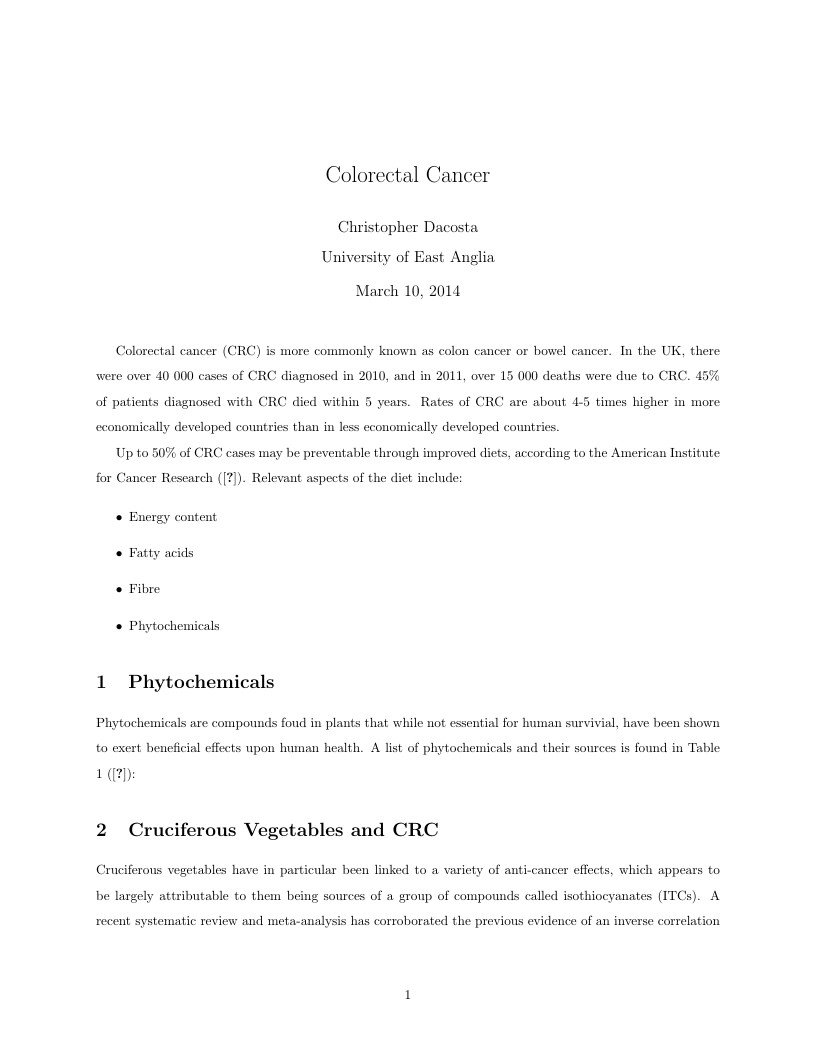
Colorectal Cancer
Autor:
Christopher Dacosta
Last Updated:
hace 12 años
License:
Creative Commons CC BY 4.0
Resumen:
Colorectal cancer and phytochemicals

\begin
Discover why over 20 million people worldwide trust Overleaf with their work.

\begin
Discover why over 20 million people worldwide trust Overleaf with their work.
\documentclass{article}
\linespread{1.6}
\usepackage[margin=1in]{geometry}
\usepackage{graphicx}
\usepackage{amsmath}
\begin{document}
\title{Colorectal Cancer}
\author{Christopher Dacosta \\ University of East Anglia}
\date {\today}
\maketitle
Colorectal cancer (CRC) is more commonly known as colon cancer or bowel cancer. In the UK, there were over 40 000 cases of CRC diagnosed in 2010, and in 2011, over 15 000 deaths were due to CRC. 45\% of patients diagnosed with CRC died within 5 years. Rates of CRC are about 4-5 times higher in more economically developed countries than in less economically developed countries.
Up to 50\% of CRC cases may be preventable through improved diets, according to the American Institute for Cancer Research (\cite{crcimagesite}). Relevant aspects of the diet include:
\begin{itemize}
\item {Energy content}
\item {Fatty acids}
\item {Fibre}
\item {Phytochemicals}
\end{itemize}
\section{Phytochemicals}
Phytochemicals are compounds foud in plants that while not essential for human survivial, have been shown to exert beneficial effects upon human health. A list of phytochemicals and their sources is found in Table \ref{tab:1} (\cite{phytochemicals}):
\begin{table}
\begin{center}
\begin{tabular}{|c|c|}
\hline
{\bf Source} & {\bf Phytochemical} \\
\hline
Turmeric & Curcumin \\
\hline
Chilli peppers & Capsiacin \\
\hline
Green tea & Epigallocatechin-3-gallate \\
\hline
Soy & Genistein \\
\hline
Red grapes/wine & Resveratrol \\
\hline
Garlic & Diallyl sulfide \\
\hline
Broccoli & Sulforaphane \\
\hline
\end{tabular}
\caption{A list of phytochemicals whose intakes are inversely correlated with CRC.}
\end{center}
\label{tab:1}
\end{table}
\section{Cruciferous Vegetables and CRC}
Cruciferous vegetables have in particular been linked to a variety of anti-cancer effects, which appears to be largely attributable to them being sources of a group of compounds called isothiocyanates (ITCs). A recent systematic review and meta-analysis has corroborated the previous evidence of an inverse correlation between cruciferous vegetable intake and CRC risk (\cite{whiteley}), with an odds ratio (OR) of 0.78. For information about how OR is calculated, see Equation \ref{eq:1}.
\begin{equation}
OR = \frac{\frac{Diseased\:and\:Exposed}{Diseased\:and\:Not\:Exposed}}{\frac{Healthy\:and\:Exposed}{Healthy\:and\:Not\:Exposed}}
\label{eq:1}
\end{equation}
\begin{figure}[h]
\begin{center}
\includegraphics[scale=1]{CRC.jpg}
\caption{A diagram depicting the different stages of the development of colorectal cancer, according to the classic model of pathogenesis. \cite{crcimagesite}}
\end{center}
\end{figure}
\bibliographystyle{plain}
\bibliography{The References File}
\end{document}